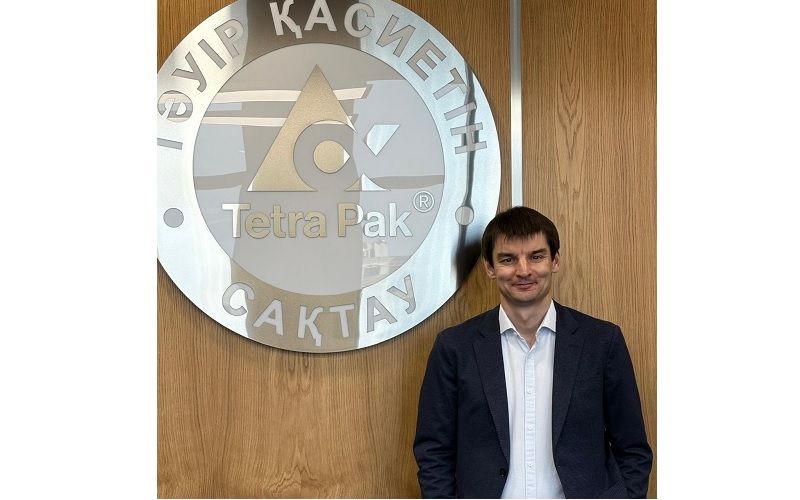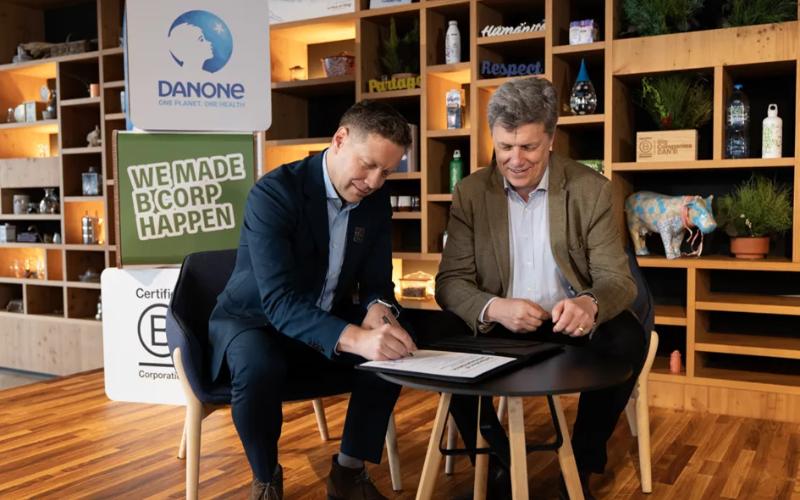Alexey Ashrafzyanov: Smart Innovations and Operational Efficiency Define the Future of the Dairy Industry

Tetra Pak continues to actively invest in the development of the dairy industry—both in terms of industrial solutions, including new equipment, milk processing technologies, and new product development capabilities, and in terms of expert support. We deeply study consumer behavior, identifying key drivers of change and trends that shape new consumer habits.
This knowledge allows us to anticipate future needs and help producers adapt to them, creating products that will be in demand in the market. We apply this approach in Central Asia, including Kazakhstan, where we offer not only technological solutions but also marketing expertise—fr om understanding consumption to distribution channels and communication methods. This helps brands speak to consumers in their language and connect with them.
What trends are you seeing specifically here in Central Asia when it comes to dairy consumption and packaging?
Today's consumer market is very vibrant and dynamic. This is evident even fr om a simple glance at store shelves: product ranges are constantly expanding, new brands are appearing, rebrandings are taking place, and new formats and subcategories are developing. All of this reflects how manufacturers strive to quickly respond to changing consumer needs.
This activity indicates intense competition and brands' desire to adapt to the current market situation. It also confirms that consumers have become more demanding and conscious, which means it's important for manufacturers to be flexible, innovative, and attentive to trends.
More broadly, how has Tetra Pak's strategy changed in recent years – from a solutions provider to a sustainability partner?
Globally, we remain focused on quality, innovation, and sustainable development. One of the key areas of our strategy is optimizing client operations—we strive to provide our partners with a competitive advantage through operational efficiency and innovation.
We apply these principles in various combinations depending on the needs of our clients in Central Asia. This approach allows us not only to adapt to changes but also to help our clients grow and develop in a dynamic market.
Today's consumers have become much more demanding—about product ingredients, the origin of milk, and the eco-friendliness of packaging. What trends do you see as key on the dairy shelf in 2025-2026?
We're seeing a demand for "naturalness"—consumers are increasingly choosing products with simple and clear ingredients. Secondly, added functional value is becoming increasingly popular: healthy products enriched with vitamins or probiotics resonate with consumers.
Emotional connection also plays a major role, especially in the context of cultural and traditional values. Products that evoke associations with native tastes or local identity are becoming especially meaningful.
Furthermore, the ability of manufacturers to adapt to changing demand is an important factor. Consumers are evolving—their habits and consumption patterns are changing, and successful brands are able to flexibly respond to these changes, offering relevant solutions.
Do you see differences between the European, Middle Eastern and Central Asian markets in how consumers perceive dairy products and choose packaging?
This is, of course, critically important, as product perception is directly dependent on consumer expectations—and these can vary significantly not only between countries but even within regions. For example, in one country, dairy products are perceived as a cooking ingredient, while in another, they are seen as part of a regular diet.
The choice of product and format is influenced by many factors: the level of retail development, consumption patterns, and cultural characteristics. Some people make large purchases once a month, while others do so twice a week. Some regions have a strong tea culture, wh ere dairy products are served to guests, while in others, we see enormous potential for on-the-go formats such as milkshakes and yogurt drinks.
Therefore, it is crucial to understand who, when, and why purchases a product—this is what determines the success of a market offering.
What influences consumer choice most now—price, brand, or format convenience?
In Kazakhstan, price remains a key factor in consumer choice, especially as consumer concerns about the cost of everyday goods grow. Dairy products are part of the basic consumer basket, and we see that brand loyalty is becoming increasingly flexible: a single consumer may have several brands in their basket.
Loyalty lasts only as long as a brand meets expectations. Therefore, it's important to be flexible – both in adaptation and innovation. Furthermore, it's worth noting that although each major brand creates a profile of its consumer, the reality is much more diverse. Segmentation must be deeper and more precise.
When a manufacturer considers its consumer in a general sense, they obtain an average result. However, if the positioning of the brand, sub-brands, and specific SKUs is aimed at clearly defined target groups, the results are typically higher. Here, it's important to consider demographics, purchasing power, and how the product and packaging functionality meet the needs of each of these groups in specific consumption situations.
How, in your opinion, should manufacturers change to not just follow trends, but to shape them?
It's important to have a solid foundation in brand positioning and consistently adhere to it. This helps maintain brand integrity and consumer trust.
Trend formation is an active process that requires the ability to identify gaps in the market, monitor global trends, and have a clear strategic vision. This applies not only to the growth of a specific brand but also to the development of the entire category. This approach allows us not only to respond to changes but to set the direction and be a leader in our segment. This is why we actively invest in understanding which hidden needs in the dairy category can be met by new launches.
One area wh ere Tetra Pak is setting the tone is sustainable solutions and the circular economy. What new developments have you seen this year?
We have launched full-scale commercial production of aseptic packaging with an aluminum-free barrier layer. This is a large-scale project that we've been working towards for several years, and today this packaging is already available to our customers.
We see strong interest in this solution fr om markets wh ere sustainability is part of the brand, as well as fr om countries that are ahead of the curve in waste management regulations. This area will become relevant for Central Asia a little later, but if our partners already have specific interest, we are always open to discussing the possibility of implementing such solutions to strengthen their positioning and expand their product lines. Furthermore, numerous equipment innovations allow milk processors to reduce specific costs for electricity, steam, water, and waste, and often offer attractive ROI for financiers and producers.
Which packaging formats, technologies, and approaches to customer communication do you think will take the lead?
The market always follows innovation—especially when it combines a new format, functional value, and a clear brand message. We've gained experience in many markets, demonstrating how this combination has transformed consumer habits. Tetra Pak's portfolio includes several solutions that meet these criteria, and we hope they will drive growth for our current and future partners.
Growth will come from those players who better understand their consumers and offer products that align with their values here and now. In Central Asia, the potential in this area has yet to be fully realized. Dairy products are often positioned toward the "average" consumer, although in reality, demographics and behavior are already significantly more diverse.
The advantage will lie with those who aren't afraid to experiment—with packaging formats, brand design, and consumer promises. Here, local producers can test new SKUs or sub-brands in specific channels or regions, observe the reaction, and, if successful, scale up.
And a final question: Tetra Pak has been supporting industry events like Aq Altyn for many years. What do you think businesses gain from participating in such dialogues—and what's important to discuss today, as the industry undergoes a period of change?
These types of communication formats are important – they help industry participants better understand each other: who's focusing on what, which segments are a priority, and how consumers perceive the category as a whole. This creates a shared vision and understanding of wh ere each manufacturer can fit in.
Furthermore, it's an opportunity to share opinions on what's truly important to the industry. I often repeat: success in the dairy industry lies in smart innovation and operational efficiency.
The demand for reducing operating costs is particularly pressing now. Tetra Pak offers solutions that help: optimize downtime, reduce losses, and improve quality. After all, stable production not only saves money but is also a prerequisite for implementing innovation.
Alexey Ashrafzyanov will speak at the AqAltyn-2025 Congress, which will take place on November 24–25 in Shymkent, presenting on the topic: “Trends in Consumer Preferences and the Transformation of the Modern Dairy Shelf.”
More information about AqAltyn is available via the link below.
General Partner and Key Engineering Partner — Borte Engineering
As a leading national manufacturer in Kazakhstan, Borte Engineering develops high-tech equipment for the food industry, with its quality recognized through inclusion in the Register of Domestic Producers. The company successfully collaborates with enterprises across Central Asia, contributing to the strengthening of the regional economy.
Innovation Partner — delaval.com/ru-kz/">DeLaval
Altyn Sponsors — alfalservice.ru/">Alfa L Service, mb-system.ru/">MB-System
Qola Sponsors — Tetra Pak, Clever Machines LLP
SPX FLOW APV | SEITAL SEPARATION
Partners — Dairy Union of Kazakhstan, Republican Chamber of Dairy and Dual-Purpose Cattle Breeds











